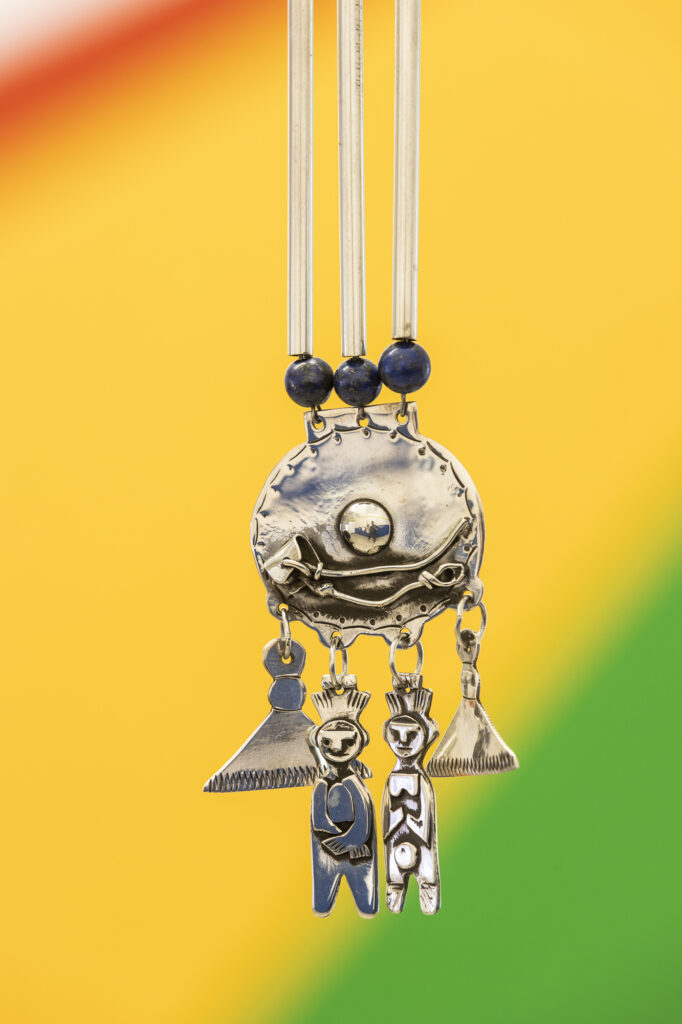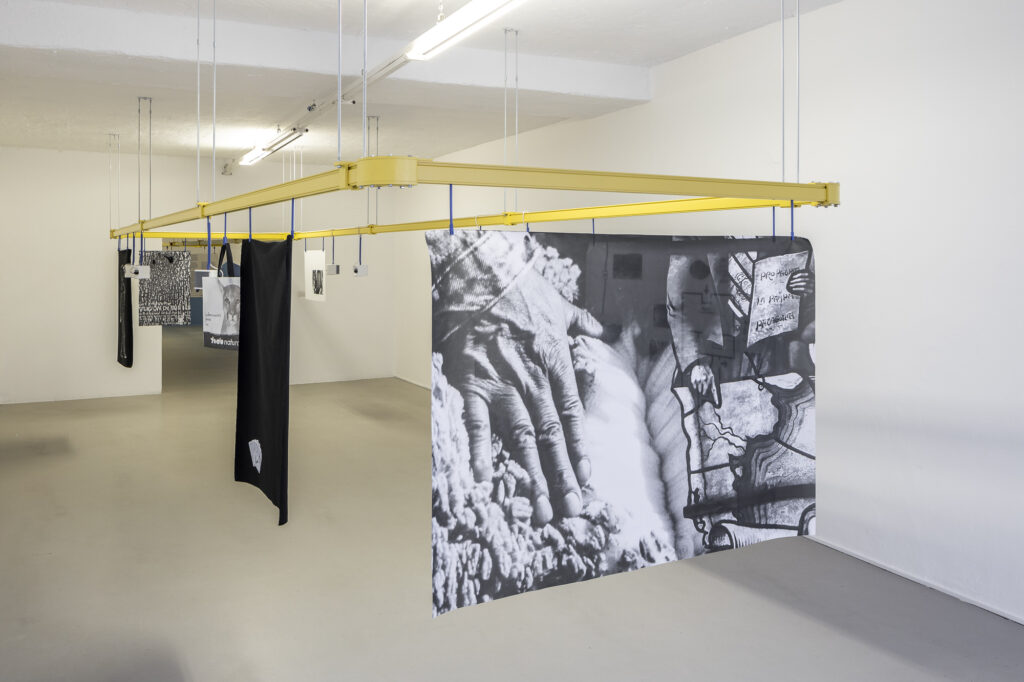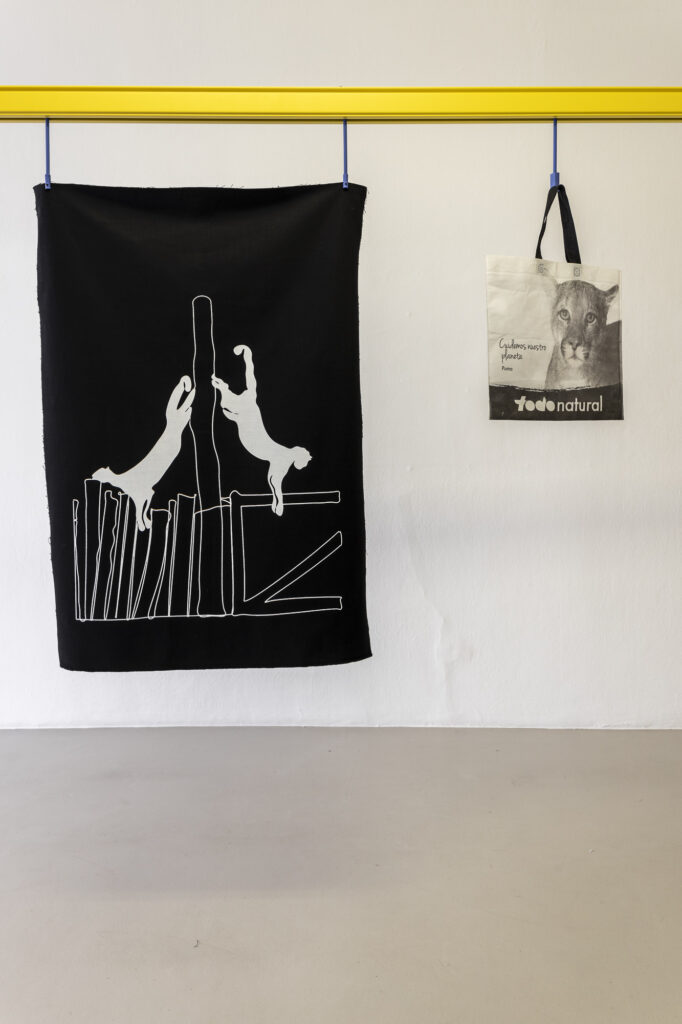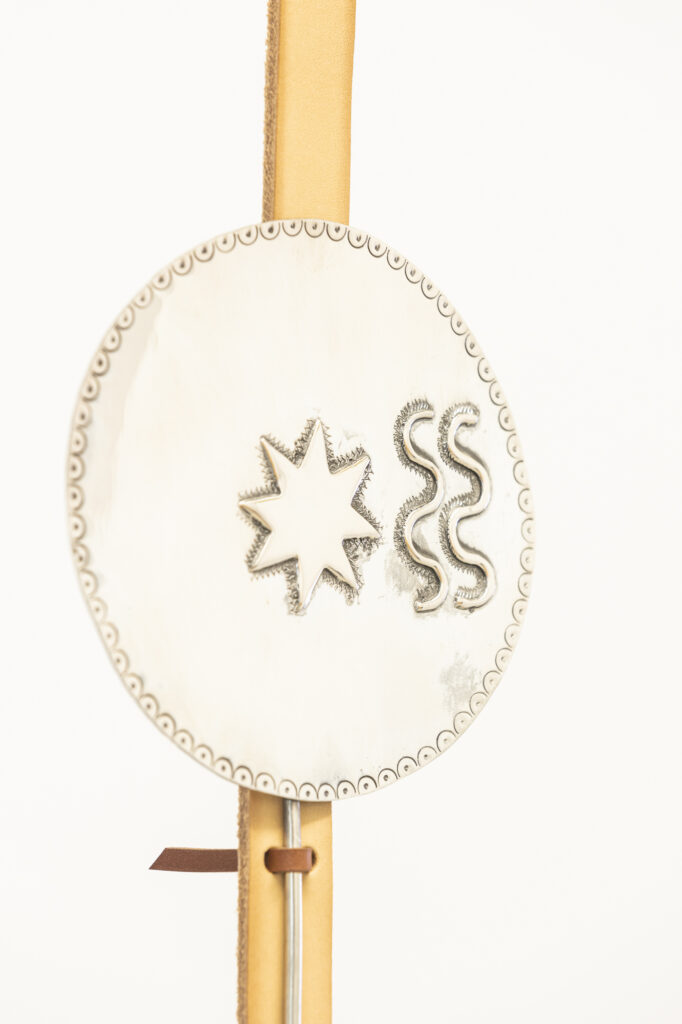
Dear Elena, thank you so much for joining us in this special issue on Donna Haraway’s notion of “staying with the trouble”. You are an Italian artist, and your creative activity is geared towards interacting with specific territories and communities. For one of your most recent projects, for which you have won the prestigious funding of the Italian Council, you have spent almost two months in Argentina with communities that are part of Indigenous groups forming the Mapuche people. With due regard to these communities and following the mindset “nothing about us without us”, you have worked in close relationship with two important figures who are the co-creators along with yourself of the Silver Rights project: one is Mauro Millán, retrafe (silversmith) and lonko (political and spiritual guide) of the Mapuche community Pillán Mahuiza, and the other is the Argentinian visual artist Eduardo Molinari. Your collaboration has given rise to an elaborate, beautiful, and strong collective installation which includes silkscreen prints, audio stories, flags, photographic montages, and silver jewelry.
♦For Silver Rights, you have embarked on a journey alongside the Mapuche who are fighting to recover their ancestral lands. What specific challenges were met in the creative process, and how did learning to navigate through these difficulties lead to meaningful art, for yourself and for the community that hosted you?
The conflict between Mapuche communities and multinational corporations in Argentina is a highly discussed topic particularly in recent years, as well as the topic of the recovery of ancestral lands in many parts of the world. Creating Silver Rights brought several challenges, considering that it touches on these sensitive issues. First was being a European in South-America and questioning the fact that a huge property was bought by a big Italian company (Benetton), well-known all over the world for its ethical campaigns (against racism, diversity, etc..). Here it was essential to define the identity of Benetton and other companies that operate nowadays in the same way: these are colonizing forces that have mutated their approach to current times, fighting through other modalities. Therefore, we have to find the right way to speak up and face them. Another most interesting challenge was to work in a respectful way towards Mapuche communities, for example by avoiding video and sound recording in order to protect them and their struggles. It was important to be able to listen to many different voices, balance them and put them into a dialogue. This was key to avoiding cultural extractivism, as it often happens when “Western” artists touch or remix elements belonging to different cultures. This, for example, led to the questioning of the cultural appropriation displayed in the Museo Leleque (created by Benetton company) and other sites, by creating a work of art that could meaningfully face these issues while at the same time being part of a European collection. The challenge with the Silver Rights project was therefore to put together different levels of narration and history in a single installation. I am very thankful to the activist group Ya Basta! Edi Bese! who had a fundamental role in this process of questioning, learning, listening and facing the struggle.

♦When entering the exhibition space, in the first large-scale composition, there is a juxtaposition of two images: it acts like an epitome of the stereotyped ideas one has to leave behind in order to get access to the meaning of Silver Rights. Can you tell us more about these images and why you chose them?
This first image was suggested by Eduardo Molinari after visiting Museo Leleque. We found a catalogue edited by the Benetton family about their properties in Patagonia and the museum itself. The image that caught our attention was the one of an indigenous hand in the gesture of parting a sheep’s fur, showing the untouched white wool hidden behind the dirty layer. A very beautiful and seductive image taken by Italian photographer Mauro Fregnan, totally following Benetton’s communication strategies’ guidelines. We wanted to use this image as a gateway to the installation, deconstructing the meaning of the image in itself by converting it into black and white, avoiding the colorful attitude used in Benetton’s advertising campaigns. But this was not enough, and that is why at some point we decided to add another image taken by Molinari in the cathedral of Bariloche: another symbolic hand gesture in the act of separating, this time showing the Conquer of the Desert towards Patagonia. In Fact here President Avellaneda (who ruled between 1874 and 1880) is indicating the boundaries on the map of Patagonia; the text on the parchment reads PROPATRIA LA PAMPA PATAGONIA. The two images, different in time and context are both “trying to seduce the observer by capitalizing on the idea of uncontaminated and unexplored knowledge”, as Emanuele Guidi correctly states in his essay[1].
♦Do you feel this project shares the combined impulse that Donna Haraway coins as “attentive practices of thought, love, rage, and care”[2], and how much do each of these terms weigh in an extensive project such as Silver Rights?
During my time in Argentina I had many conversations about care and respect both with Mapuche communities as well as with others involved in the project. We spoke about care and love towards other humans, towards nature, towards other species. Mapuche means ‘people of the land’ and their entire life is based on living in symbiosis with other species as well as the nature we co-inhabit. While speaking with Eduardo Molinari, he shared the work of Mario Vilca, a professor with deep roots in South American Andean thought, the one of mutua crianza (Mutual Nurturing). Mutual Nurturing means to inhabit a conversation and a commensality with all non-human beings (stones, plants, animals, mountains, waters, clouds, lightning, stars and also the ancestors, spirits, tutelary entities and deities). As Eduardo writes in Silver Rights, ‘we are all invited to talk and listen, to eat and be eaten, without exclusions. […] Learning to listen and converse with non-human beings is an urgent necessity in our struggle for greater spatial, environmental and social justice.”[3]
♦ In your opinion, to what extent can artists be involved with communities that are directly affected by some of the most violent forms of economic activity, and how can they learn from and assist them? For example, in the catalogue[4], the curator Emanuele Guidi speaks of the Silver Rights project as a “diplomatic operation”[5], and at the same time he recalls the importance of the “art of diplomacy” as a fundamental attitude that underlies Mapuche’s mode of action. How important was this diplomatic aspect in your mindset for this project?
Mapuche people are very much into dialogue and debate. I learned a lot by participating in some of their meetings (for example the Parlamento del Agua, the “Water Parliament”). They always listen to each other and there are no imposed time limits for the answer. You have to take your time to find your own way of creating a dialogue and how to discuss matters. No one speaks over each other, and everyone helps out in shared tasks. It is interesting to read what Mauro Millán and Ana Margarita Ramos write in the “Mapuche Silverwork” essay in the exhibition catalogue:
Until 140 years ago the Mapuche-Tehuelche people
were sovereign in their land. The grandparents and the
great-grandparents who survived the genocide caused by
the military campaigns launched by the Argentinian and
Chilean states at the end of the 19th century, still tell, in the
warmth and safety of their homes, detailed stories about
those years. These were the times when the machis (healer) received
important messages and guidance for collective decision-
making, the times when ‘riches sprang from the surface
of the earth’, and the times when there was a fluid conversation
between people and the spirits, the guardians of nature
and the forces of the land. In those years, the Argentinian state had just begun its
policy of eviction and massacre of the Indigenous people.
The various lofche (communities) living in the southern part
of Buenos Aires province were attacked by three military
columns, and therefore forced to move South of the Colorado
River. However, several futa trawun (parliaments) were immediately
held among the lonkos of different regions and the
lofche were re-established. Along these moving and changing
borders between the Indigenous communities and the creoles
(people of European descent), there were periods of peace
and trade, in which different goods, including silver, were
exchanged. For the Mapuche, these were important occasions
to obtain raw material in the form of coins or other objects. In
the mid-19th century, the pu lonkos (chiefs), machis and other
authorities, but also the pu ulmen (wealthy men) and pillan
kushe (female leaders) usually wore precious silver jewelry.
Despite the unstable and transitory alliances and peace
agreements with the emerging states of Argentina and Chile,
the 19th century (until the 1870s and 1880s) was a time of
political autonomy and economic prosperity for Mapuche-
Tehuelche society. In fact, Mapuche-Tehuelche people accumulated
a large amount of silver in the form of coins, which
they did not exchange again and transformed instead into
personal objects used for political and spiritual purposes.
Some lonkos came to acquire a large quantity of coins and
were able to create their own jewelry collections with
them. As a consequence of this reuse of money, some foreign travelers
reported that in those years there was a great
shortage of currency in all the border provinces to the West
and East of the Cordillera. Coins were hammered or melted
down to become the raw material on which the silversmith
would leave the mark of his people. With these spontaneous
and collective actions, coins were separated from the
economic logic of the states.[6]
I chose to work with jewelry because I saw its materiality as a symbol of this fight for the land. The jewelry is not just jewelry, is becomes a symbol for the community, a symbol of diplomacy. In fact it is used in rituals, ceremonies, and political actions. It has a performative function that perfectly translates all the questions I wanted to debate in the Silver Rights project, and that is why it is at the core of it.
♦ As Haraway states, “We are obligated to speak from situated worlds, but we no longer need to start from a humanist patriline and its breath-taking erasures and high-wire acts.”[7] Silver Rights mobilizes a wide range of humans and “critters” alike, like pumas, a dragon spirit, lakes and silver. Is the broader concept of “worlding”, in the sense Haraway uses it and which can be summarized as “co-operative and conflictual ways of world-making in which different species, technologies and forms of knowledge interact”[8] effective to describe your artistic approach? The opposite of this creative and generous attitude would be the “corporate unworlding” and “unworldings of the Capitalocene”[9]Haraway speaks of, which directly echoes the undertakings of the Benetton multinational in Patagonia.
Listening and creating dialogue is at the base of my research process. I am a very curious person, and I think the only way to experience other worlds, other points of view, is by sharing a physical space together, getting to know the context and creatures living in that specific piece of land, sky, mountain, river, city. I feel the necessity to find new balances, and creating new narratives that are between reality and fiction is a great way for me to enlarge this vision, to create new worlds. In Silver Rights, the show opens up with 4 audio works, dialogues co-written with Eduardo Molinari and writer and researcher Enrica Camporesi. We imagined new worlds by letting Carlo Benetton have a dialogue with the mountains and the wind, or by having the symbol of Wales (the dragon, present on the flag) observing the activity of four Argentinian politicians belonging to different times and generations playing poker in an ex Welsh colony in the middle of Patagonia. Two pumas are also present in the stories, an animal that is seen as a prey and hunted by white men, but instead as a sacred animal for the Mapuche. I wanted to help the viewer with some key images while listening to the audio works, so I added some very straightforward and simple ones. For the first audio, where the pumas are interacting with the politicians, I silk-screened a drawing that was originally a picture I took in Patagonia: while driving I found two pumas, killed and exhibited as a trophy at the entrance to a farm belonging to a German family (I discovered later on that they were relatives of people involved in the so called “Conquest of the Desert”). The image was so devastating to me that I had to simplify it and turn it into a drawing. Next to it, I placed a shopping bag I found in a supermarket: a cute puma’s face is printed on it stating “we have to take care of our planet”. These images are in contradiction to the audio episode where the pumas finally recover their agency. The audio works are very important to me because they use the same oral narration style as the Mapuche. The audios are mandatory to access the rest of the show: one has to listen to them before seeing the jewelry. The audio episodes are thus intended as a means to provide information to the public so they can access the indigenous objects with respect. At the same time, the audios act as a way to “protect” the jewelry on show.

♦Is there a particular piece or a particular moment of the Silver Rights project that best represents this action of resistance against the “unworlding” of corporate greed, and that embodies the creative and generative action of “worlding”?
I would say that the best example is the Mapuche communities fighting for their land, re-inventing their rituals and recovering their language, brutally cut off by colonialism and capitalism. They are inventing new worlds, based on the knowledge they still bring with them through the presence of their ancestors, fluently mixed with all natural elements they are part of. Because they do not distinguish elements: natural forms are alive, they are active subjects of their life, they are included in the decision-making process. We humans are nature, and we cannot survive if we don’t find a balance between all living beings on the planet. Mapuche are very conscious of their history and of their current situation. They are facing big corporations with what they have: rituals and stones. They took a decision: to slow down and live simply. And it is sad that many of “us” still consider this as a step-back (in “evolution”).

♦Silver and silverwork is central to this project. For the Mapuche people, silver is imbued with such a greater significance than none of the people and states that have deprived the Mapuche communities of their jewelry, for commercial ends or colonial curiosity, could ever understand. As is explained in the exhibition catalogue:
“Lien (silver), which is a part of the moon materialised on earth, became the physical element through which the relationship between the moon and the mapu’s living beings, especially women, was mediated. Lien protects these living beings from the wesha newen (forces in disharmony) and from their disruptive effects on human feelings (envy, jealousy, revenge, conflicts).”[10]
This makes me think of this passage in Haraway’s book about the Navajos and the Churro sheep, the art of weaving, and the beautiful notion of hózhó — which could be translated from navajo as “the right relation of the world”[11]. Lien — silver, has this power for the Mapuche. Haraway states that “Restoring the land, animals, and people to hózhó is an ongoing process that continues to require continuous weaving. The colonial and capitalist structures of both exterminations have not been dismantled.”[12]. To me, Silver Rights is “[…] staying with the trouble of inheriting the damages and achievements of colonial and postcolonial naturalcultural histories in telling the tale of still possible recuperation”[13]. Do you feel you have participated in a process of restoration? Which part of Silver Rights in particular evokes this sense of recuperation and of restoration for you?
This question is very interesting to me. When I proposed to the Mapuche that together we could find new symbols to be engraved and translated on the silver jewelry, they agreed. Then, after many discussions, when we were about to define these symbols, they told me it was partially an unnecessary process to do. As they explained it to me, we were already giving new meaning to the symbols by recuperating them and finally bringing the jewelry pieces to their original size (note: at the beginning, pieces of jewelry had very big dimensions. Then, in the last few decades Mapuche communities became poorer and poorer due to the ongoing land grabbing, so they had less access to silver, and the jewelry became smaller). We had dialogues, discussed and argued. At the beginning, I couldn’t understand why Mapuche didn’t want to include new symbols to talk about a ‘new’ situation, the one of land grabbing. I was told that this was a very western vision, where new corresponds to new. But the act of recovering in this case was intended as a way to bridge the present time with their history, their beliefs, their connection with their ancestors. Then I understood, and I totally agreed. At the same time Mapuche also agreed to include new symbols, such as waves to define the fight to access to water (rivers have been fenced off by big corporations – Benetton included), or the slingstone, the weapon mapuche use to throw stones when police are attacking their communities. That is how a balance was found.
♦Silver Rights has been exhibited in 2021 at the ar/ge kunst Gallery of Bolzano in Italy, at the Södertälje Konsthall in Sweden, and will be part of the International Biennial of Contemporary Art of the South, BIENALSUR, in Argentina until April 2022. The Museum of Contemporary Art Castello di Rivoli in Italy will then act as custodian of the silver jewelry and installation emanating from this project. But there are two sets of jewelry, right?
Yes, actually we have three sets. One will be at Castello di Rivoli as part of the permanent collection, one (intended as an exhibition copy) is traveling the world to make the project as widespread as possible, while the last one is at the Mapuche community of Pillan Mahuiza. This was an agreement we made with Mapuche before winning the production grant and it was an important decision for all of us.
Interview conducted in Torino, Circolo dei Lettori
Elena Mazzi and Raphaelle Occhietti
[1] Emanuele Guidi in Guidi, Emanuele and Elena Mazzi, eds., Silver Rights, Berlin: Archive Books; Bolzano: ar / ge kunst, 2021, p.284
[2] Donna Haraway, Staying with the Trouble: Making Kin in the Chthulucene (Durham: Duke University Press). 2016, p. 56.
[3] Eduardo Molinari in Guidi, Emanuele and Elena Mazzi, eds. 2021. Silver Rights, p. 356-357.
[4] Guidi, Emanuele and Elena Mazzi, eds. 2021. Guidi, Emanuele and Elena Mazzi, eds. 2021. Silver Rights,
[5] Donna Haraway, Staying with the Trouble: Making Kin in the Chthulucene (Durham: Duke University Press). 2016, p. 291.
[6] Mauro Millán and Ana Margarita Ramos in Guidi, Emanuele and Elena Mazzi, eds., Silver Rights, Berlin: Archive Books; Bolzano: ar / ge kunst, 2021, p. 301-302.
[7] Donna Haraway, Staying with the Trouble: Making Kin in the Chthulucene (Durham: Duke University Press). 2016, p. 132.
[8] Definition given by Pisters, Patricia and Stephan Besser. 2016. https://worldingthebrain2016.com.
[9] Donna Haraway, Staying with the Trouble: Making Kin in the Chthulucene (Durham: Duke University Press). 2016, p. 56.
[10] Mauro Millán and Ana Margarita Ramos in Guidi, Emanuele and Elena Mazzi, eds., Silver Rights, Berlin: Archive Books; Bolzano: ar / ge kunst, 2021, p. 294.
[11] Donna Haraway, Staying with the Trouble: Making Kin in the Chthulucene (Durham: Duke University Press). 2016, p. 14.
[12] Donna Haraway, Staying with the Trouble: Making Kin in the Chthulucene (Durham: Duke University Press). 2016, p. 93.
[13] Donna Haraway, Staying with the Trouble: Making Kin in the Chthulucene (Durham: Duke University Press). 2016, p. 125.
